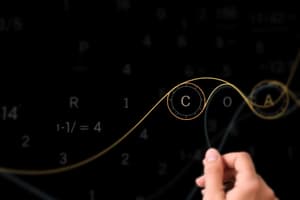Podcast
Questions and Answers
What is the defining characteristic of the Fibonacci sequence?
What is the defining characteristic of the Fibonacci sequence?
- Each number is the sum of the two preceding ones. (correct)
- Each number is double the value of the previous one.
- Each number is determined by the square root of the previous two.
- Each number is the product of the two preceding ones.
How can knowledge of the Fibonacci sequence be useful in computer programming?
How can knowledge of the Fibonacci sequence be useful in computer programming?
- It assists in network security protocols.
- It helps in creating visual effects.
- It aids in audio processing algorithms.
- It speeds up the process of string matching. (correct)
In what area can population growth benefit from applications of the Fibonacci sequence?
In what area can population growth benefit from applications of the Fibonacci sequence?
- Predicting voting patterns
- Estimating future currency exchange rates
- Understanding bacterial colony expansion (correct)
- Determining geological weather patterns
Which of the following statements about Fibonacci numbers in nature is true?
Which of the following statements about Fibonacci numbers in nature is true?
How does understanding the Fibonacci sequence contribute to making predictions about future generations?
How does understanding the Fibonacci sequence contribute to making predictions about future generations?
What is one of the most well-known applications of the Fibonacci sequence mentioned in the text?
What is one of the most well-known applications of the Fibonacci sequence mentioned in the text?
How does the Fibonacci sequence contribute to the design of spirals in seashells, hurricanes, and galaxies?
How does the Fibonacci sequence contribute to the design of spirals in seashells, hurricanes, and galaxies?
What is a primary way Fibonacci numbers manifest themselves in plant life?
What is a primary way Fibonacci numbers manifest themselves in plant life?
In plant life, how do leaf angles correspond to Fibonacci numbers?
In plant life, how do leaf angles correspond to Fibonacci numbers?
How do snails and mollusks use the Fibonacci sequence in nature?
How do snails and mollusks use the Fibonacci sequence in nature?
Flashcards are hidden until you start studying
Study Notes
Fibonacci Sequence
The Fibonacci sequence is a mathematical series where each number is the sum of the two preceding ones. It starts with 0 and 1, followed by every subsequent number being the sum of the previous two. This seemingly simple pattern has fascinated mathematicians and artists alike due to its numerous applications and occurrences in nature. Here's a deeper look into this fascinating sequence along with some of its uses and natural appearances.
Applications
The Fibonacci sequence has practical applications beyond just mathematics. One common application is in computer programming, specifically in algorithms involving string matching or searching. For instance, when looking for patterns within strings, knowing how to calculate the nth term of a sequence can help speed up the search process significantly.
Another important application is in understanding population growth patterns. When you know how fast a bacterial colony expands, for example, you can predict how many bacteria there will be after a certain amount of time based on the Fibonacci sequence. This can also be applied to human populations—if you know the difference between one generation and the next, it becomes possible to estimate the size of the current generation and make predictions about future generations.
In addition, the Fibonacci sequence plays a role in determining the optimal price points for goods sold in sets of three, such as chocolate bars, DVDs, or clothing items; consumers tend to view things in threes more favorably due to psychological effects related to the sequence.
One of the most well-known applications of the Fibonacci sequence is in the design of spirals found in seashells, hurricanes, and galaxies. These spirals grow outward from a central point, like petals on a flower or layers on an onion, with each layer growing longer than the last. As these structures develop, they follow a spiral path described by the Fibonacci sequence, resulting in beautiful and intricate designs that frequently appear throughout the natural world.
Fibonacci Numbers in Nature
The Fibonacci sequence appears so often in nature because it helps describe the proportions of living organisms, particularly their shapes, sizes, and arrangements. Consider a pinecone or sunflower; both have seed arrangement patterns that conform to the Golden Ratio, which can be expressed using Fibonacci numbers. In other words, if you divide the largest petal length by the second-largest petal length, the result is approximately equal to the Golden Ratio, which is around 1.618. This ratio is pivotal in understanding the beauty and functionality of many natural objects.
One of the primary ways Fibonacci numbers manifest themselves in plant life is through phyllotaxis, which refers to the arrangement of leaves on a stem. Leaves grow spaced apart in a helix shape, creating what looks like a vortex. Each leaf angle corresponds to numbers in the Fibonacci sequence when measured against a central axis. For example, the first leaf is usually 0 degrees, the second leaf may be at 90 degrees, the third at 120 degrees, and so on. The angles between leaves in various plants correspond with the Fibonacci sequence, contributing to the overall aesthetic appeal of natural landscapes.
In addition to flora, animals too exhibit aspects of the Fibonacci sequence. A famous example is the shells of snails and mollusks, which spiral outwards following the Fibonacci sequence as they grow. From a distance, these shells create beautiful and intricate patterns that would seem random but actually follow strict mathematical rules set forth by the Fibonacci sequence.
Conclusion
The Fibonacci sequence is more than just a math problem to solve. Its presence in our daily lives and in the universe around us lends credibility to the idea that nature follows certain underlying principles. By studying these sequences, we gain insights into the secrets hidden beneath the surface of seemingly randomly occurring events. Whether in computer algorithms, business strategies, art, music, physics, or biology, the Fibonacci sequence continues to inspire wonder and discovery as it reveals itself across diverse fields of study.
Studying That Suits You
Use AI to generate personalized quizzes and flashcards to suit your learning preferences.




